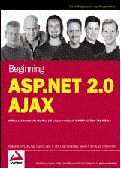|
What Is AJAX?
Advantages of AJAX
History of AJAX
What Is AJAX?
So into this development environment comes a set of technologies that are
collectively referred to as AJAX. If you are an “old guy” developer like me,
then AJAX represents a similar concept to the client-server development
mentioned earlier in the chapter. With client-server development, the amount of
data transferred is minimized over a terminal application by transferring only
the necessary data back and forth. Similarly, with AJAX, only the necessary
data is transferred back and forth between the client and the web server. This
minimizes the network utilization and processing on the client.
Advantages of AJAX
The advantages of AJAX over classical web-based applications include:
-
Asynchronous calls — AJAX allows for the ability to make asynchronous calls to
a web server. This allows the client browser to avoid waiting for all data to
arrive before allowing the user to act once more.
-
Minimal data transfer — By not performing a full postback and sending all form
data to the server, network utilization is minimized and quicker operations
occur. In sites and locations with restricted pipes for data transfer, this can
greatly improve network performance.
-
Limited processing on the server — Along with the fact that only the necessary
data is sent to the server, the server is not required to process all form
elements. By sending only the necessary data, there is limited processing on
the server. There is no need to process all form elements, process the
ViewState, send images back to the client, or send a full page back to the
client.
-
Responsiveness—Because AJAX applications are asynchronous on the client, they
are perceived to be very responsive.
|

Book Excerpt: Introduction to ASP.NET AJAX
Chapter Contents
This excerpt from
Beginning ASP.NET 2.0 AJAX by Wallace B. McClure, Paul Glavich,
Steve C. Orr, Craig Shoemaker, Steven A. Smith, Jim Zimmerman, is printed with
permission from Wrox Publication.
|
-
Context — With a full postback, users may lose the context of where they are.
Users may be at the bottom of a page, hit the Submit button, and be redirected
back to the top of the page. With AJAX there is no full postback. Clicking the
Submit button in an application that uses AJAX will allow users to maintain
their location. The user state is maintained, and the users are no longer
required to scroll down to the location they were at before clicking Submit.
History of AJAX
For all its perceived newness and sexiness, the technologies that make up AJAX
are really not new. The ability to communicate back to the server through a
hidden frame without posting the main page back to the server has been around
for a long time. Communication between client and server has been available—
back to the release of Internet Explorer’s ability to script ActiveX controls
on the client browser and to the MSXML component, both of which date back into
the late 1990s. Personally, I saw the first formal usage of client script and
MSXML in 2003. The problem with the technology at that time was the need to
manually create the necessary client-side JavaScript. In 2003, there was too
much code overall that had to be written and too much custom code that had to
be written to get this to work. Only since the second half of 2005 have
client-side libraries and server-side support for ASP.NET started to make their
presence felt and been used significantly.
|
The mainstream development community has only recently started using the
technique. The release of Google’s Suggest and Maps are what really opened the
eyes of the users to the development technologies. These applications sent a
shockwave through the development community.
Page
1 | page
2 | page
3 |
page 4 |
page 5 |
page 6 |
page 7 |
page 8
More Related links
Answer - ASP.NET Ajax Framework is used for implementing the
Ajax functionality......
Answer - Back functionality cannot work because the dynamic
pages don’t register themselves to the browsers history engine..........
With AJAX, only the necessary data is transferred back and forth between the
client and the web server. This minimizes the network utilization and
processing on the client...........
AJAX is a general umbrella term. AJAX itself stands for Asynchronous JavaScript
And XML..........
ASP.NET 2.0 AJAX is an AJAX-oriented .NET library that runs on .NET 2.0. Though
ASP.NET 2.0 AJAX is an AJAX library and can be used to perform AJAX operations,
it is really much more. ASP.NET 2.0 AJAX offers many of the same types of
features of the server-side ASP.NET............
|